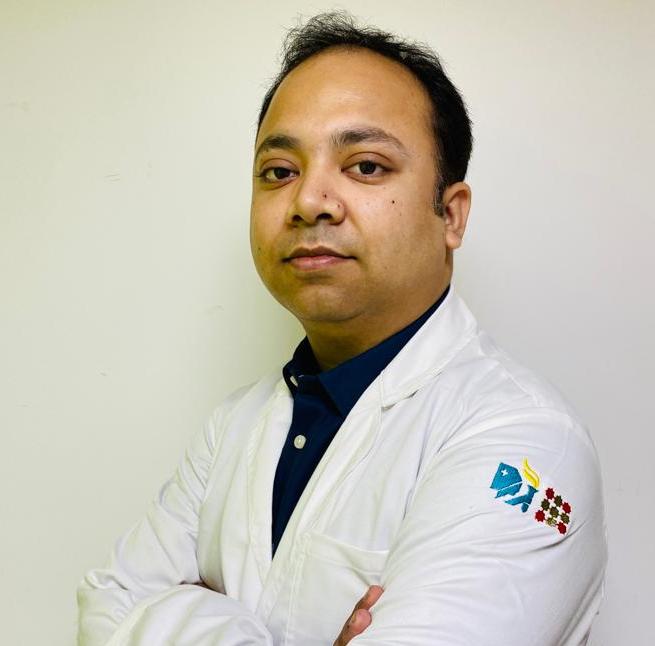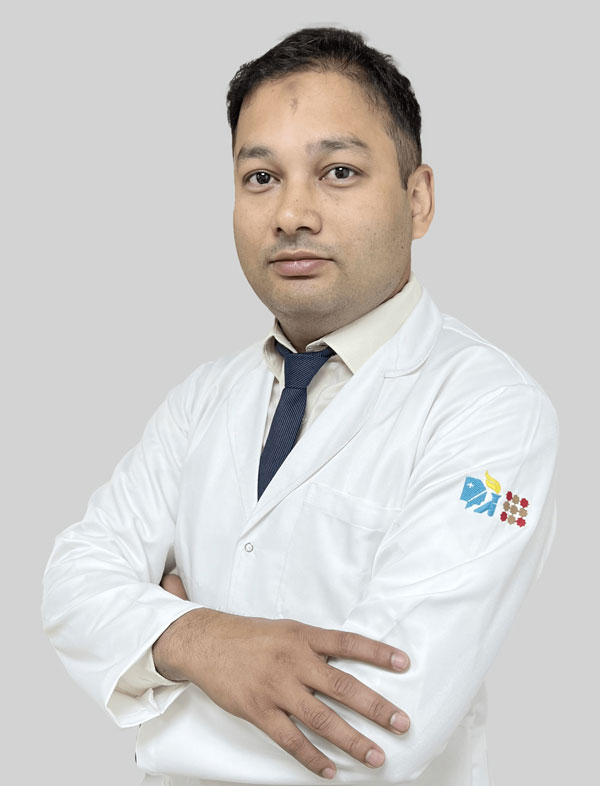Breast Cancer
Breast cancer refers to an abnormal growth of the cells of the breast. Though predominant in women, it is also known to occur in Men. If diagnosed at an early stage, there is a 95% chance of a cure for breast cancer.
Breast cancer refers to an abnormal growth of the cells of the breast. Though predominant in women, it is also known to occur in Men. If diagnosed at an early stage, there is a 95% chance of a cure for breast cancer.
- Invasive ductal carcinoma: It is the most common type of breast cancer. It arises from the milk ducts and spreads to the surrounding breast tissue.
- Invasive lobular carcinomas: They arise from the milk-producing lobules of the breast. These tumors are multiple, and sometimes patients can have simultaneous lesions bilaterally i.e. in both the breasts.
- Angiosarcoma: It is a cancer of the inner lining of blood vessels, and it can occur in any part of the body, including breasts.
- Ductal carcinoma in situ (DCIS): It is a non-invasive cancer which affects the lining of the milk ducts in the breast. As the nomenclature ‘in situ’ suggests, this cancer remains localized. Ductal carcinoma in situ, if detected in an early stage, is highly treatable, but if left untreated or undetected, can spread into the surrounding breast tissue.
- Inflammatory breast cancer: Inflammatory breast cancer is a rare type of breast cancer. It is known to develop rapidly and causes swelling, redness and tenderness in the affected breast. It develops as a result of blockage of the lymphatic vessels by cancer cells that spread to the adjacent lymph nodes and tissues.
- Invasive lobular carcinoma: When cancer begins in the milk-producing glands (lobules) of the breast and has a tendency to spread to the adjacent lymph nodes and other areas of the body, it is called Invasive lobular carcinoma. This type of cancer is the second most common following invasive ductal carcinoma.
- Male breast cancer: Though breast cancer is most commonly thought of as a disease that affects women, rarely, it may also occur in men. Male breast cancer is most common in older men, though it can occur at any age. Men diagnosed with male breast cancer at an early stage have a good chance of a cure.
- Paget’s disease of the breast: It is a rare form of breast cancer. Paget’s disease of the breast starts on the nipple and extends to the dark circle of skin (areola) around the nipple. This type of cancer occurs most often in women over the age of 50.
- Metastatic Breast cancer: It is a breast cancer that has spread beyond the primary site of origin in the breast, and to nearby lymph nodes, and other parts of the body (most often the bones, lungs, liver or brain).
- Non-cancerous breast conditions: Benign (non-cancerous) breast conditions are very common, and most women have them. In fact, most breast changes are benign. Some benign breast conditions have a higher risk of converting into cancer later.
- Non-cancerous breast conditions are not a type of Breast cancer. Mentioning below how this can be mentioned instead.
- Modifiable risk factors
- Alcohol
- Smoking
- Physical inactivity
- Obesity (especially after menopause)
- Having the first child after the age of 30yrs
- Abstaining from Breastfeeding
- Hormone replacement therapy
- Recent oral contraceptive pill usage
- Stress/anxiety
- Non-modifiable risk factors
- Growing older – the risk of breast cancer increases with age.
- Increased breast density
- Genetic mutations
- Early menarche
- Radiation to the thoracic area during the early years for some other condition.
- Late menopause
- Lump in the breast/ underarms
- Thickening or swelling of part of the breast.
- Dimpling of breast skin.
- Redness or flaky skin in the nipple area or the breast
- Pulling in of the nipple or pain in the nipple area.
- Nipple discharge other than breast milk, including blood.
- New-onset spontaneous nipple discharge
- Any change in the size or the shape of the breast.
- Pain in any area of the breast.
Mammogram
Mammogram is a modality to image the breast, using low-dose X-rays. It can help detect abnormalities within the breast tissue such as lumps, micro-calcifications etc. Including those abnormalities that are not palpable by one’s own hand. Hence, helps detect breast cancer at an early stage. Mammograms can be used as a screening as well as a diagnostic tool.
During a mammogram, the individual’s breast is compressed between two flat plates on the mammography machine. This helps to spread out breast tissue to enable the X-rays to capture a clearer image of the breast anatomy and also helps reduce the number of X-rays required to image the breast.
3D Full Field Digital Mammogram & Tomosynthesis
This is an advanced technology in mammography, also called 3D mammography. It captures multiple images of the breast tissue by an X-ray tube that moves in an arc, which is reconstructed to form a 3D image of the breast, for better visualization and clarity.
These two modalities may be supplemented by an ultrasonography of the breast, to better delineate a breast lesion.
Another latest development in mammography technology is Contrast-enhanced mammography (CEM), wherein a special dye is injected intravenous, and a mammogram is taken in the usual manner, which shows areas of increased blood supply to the breast, hence helping in better delineation of a suspicious breast lesion.
Biopsy
An ultrasound-guided breast biopsy is done to confirm whether the tumor is benign or malignant to further characterize it. For lesions that are not visible on the ultrasound and not palpable, a Stereotactic breast biopsy under Tomosynthesis guidance is done. Wire localization using ultrasound/ tomosynthesis/ mammogram is done for clinically non-palpable lesions which help aid in tumor removal.
Treatment for breast cancer involves a multidisciplinary approach, with a joint management plan made by the breast surgeon, medical oncologist and radiation oncologists. It depends on the age of the patient, stage of the disease, tumour size, grade, and immunohistochemistry.
The following are the most often performed surgical interventions to treat Breast cancer:
- Breast-Conserving Surgery (BCS): This type of surgery is where a cancerous lump is removed with a rim of surrounding normal breast tissue, and the remaining breast tissue is preserved.
With recent advances in Plastic surgical techniques, the remaining breast tissue is refashioned to ensure better cosmesis, which is called Oncoplasty. Occasionally, a pedicled flap may be required to fill in the defect caused by the removal of the cancerous lump. - Mastectomy- It is the removal of the entire breast, its internal anatomical structures like lobules, ducts, fatty tissue and the overlying skin, including the nipple and areola.
- Modified Radical Mastectomy- Removal of the entire breast with nipple and areola complex, and the regional axillary lymph nodes.
- Breast reconstruction:- Many women who have surgery to remove an entire breast have the option of having the shape of the removed breast rebuilt – Reconstructive surgery Surgery to reconstruct the breasts can be done at the time of the mastectomy or after breast cancer treatment has been completed. This can be done months or even years after the mastectomy.
Women who choose to have breast reconstructive surgery have several options :- Breasts can be rebuilt using implants (saline or silicone).
- They can also be rebuilt using autologous tissue (that is, tissue from elsewhere in the body).
- Sometimes both implants and autologous tissue are used to rebuild the breast.
- Sentinel Node Biopsy: Surgical procedure used to determine whether cancer has spread beyond a primary tumor into the lymphatic system. A single-dye or a dual-dye technique may be used to perform the above procedure. Post identification the nodes are removed and analyzed for the spread of cancer, by frozen section or routine histopathology.
- Axillary lymph node dissection: Removal of lymph nodes in the armpit (axilla). This procedure is usually performed once the spread of cancer has been confirmed through the Sentinel Node Biopsy procedure.
Variation in the levels of discomfort or pain may differ depending on:
- The size of your breasts
- Timing of the exam related to your menstrual cycle
- The skill level of the technician performing your mammogram and
- The positioning of your breast
Why Choose Apollomedics
Apollo Hospital Lucknow is one of the recognised centres for best treatment of Breast Cancer. Cancer Treatment at Apollo Hospital Lucknow has a multidisciplinary team of doctors (Surgeons, Radiation oncologists & Medical oncologists) who address all dimensions of treatment, for the best outcome. For any query related to Breast Cancer or to book an appointment with our Cancer Experts,
Please contact our 24×7 Cancer Care Helpline: 8429021812 or 8429029838.
Doctor’s Profile

Dr. Saket Pandey

Dr Ekta Sharma

Dr.Farhan Ahmad

Dr. Animesh Agrawal

Dr. Zeeshanuddin Ahmad’s

Dr Sathish Kumar Anandan




